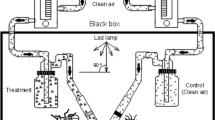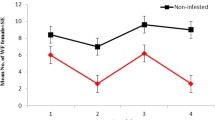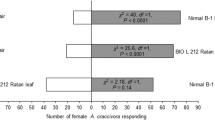Abstract
The repellencies of 13 labiate essential oils against Myzus persicae were investigated with a linear track olfactometer. Rosemary, thyme, peppermint, lavender, and spearmint oils repelled aphids at a dose of 10 μl. Rosemary and thyme oils repelled at a dose of 1 μl. The repellent actions of 13 components of rosemary oil were also evaluated. Among these components linalool, d,l-camphor, and α-terpineol had repellent action. The repellency of rosemary oil in a screenhouse was investigated. Aphids were released in a screenhouse and allowed to choose between tobacco plants in an area permeated with rosemary oil odor and plants in a control area. The number of aphids in the treatment area was about 70% of that in the control area. These results indicated that the landing of M. persicae on host plants was influenced by odors and that it may be possible to control aphids with repellents.
Similar content being viewed by others
REFERENCES
Chapman, R. F., Bernays, E. A., and Simpson, S. J. 1981. Attraction and repulsion of the aphid, Cavariella aegopodii, by plant odors. J. Chem. Ecol. 7:881–888.
Hardie, J., Isaacs, R., Pickett, J. A., Wadhams, L. J., and Woodcock, C. M. 1994. Methyl salicylate and (−)–(1R,5S)–myrtenal are plant–derived repellents for black bean aphid, Aphis fabae Scop. (Homoptera: Aphididae). J. Chem. Ecol. 20:2847–2855.
Hori, M., and Komatsu, H. 1997. Repellency of rosemary oil and its components against onion aphid, Neotoxoptera formosana (Takahashi) (Homoptera: Aphididae). Appl. Entomol. Zool. 32:303–310.
Isaacs, R., Hardie, J., Hick, A. J., Pye, B. J., Smart, L. E., Wadhams, L. J., and Woodcock, C. M. 1993. Behavioural responses of Aphis fabae to isothiocyanates in the laboratory and field. Pestic. Sci. 39:349–355.
Kennedy, J. S., Booth, C. O., and Kershaw, W. J. S. 1959. Host finding by aphids in the field. I. Gynoparae of Myzus persicae (Sulzer). Ann. Appl. Biol. 47:410–423.
Nottingham, S. F., and Hardie, J. 1993. Flight behaviour of the black bean aphid, Aphis fabae, and the cabbage aphid, Brevicoryne brassicae, in host and non–host plant odour. Physiol. Entomol. 18:389–394.
Nottingham, S. F., Hardie, J., Dawson, G. W., Hick, A. J., Pickett, J. A., Wadhams, L. J., and Woodcock, C. M. 1991. Behavioral and electrophysiological responses of aphids to host and nonhost plant volatiles. J. Chem. Ecol. 17:1231–1242.
Pettersson, J., Pickett, J. A., Pye, B. J., Quiroz, A., Smart, L. E., Wadhams, L. J., and Woodcock, C. M. 1994. Winter host component reduces colonization by bird–cherry–oat aphid, Rhopalosiphum padi (L.) (Homoptera, Aphididae), and other aphids in cereal fields. J. Chem. Ecol. 20:2565–2574.
Sakuma, M., and Fukami, H. 1985. The linear track olfactometer: An assay device for taxes of the german cockroach, Blatella germanica (L.) (Dictyoptera: Blattellidae) toward their aggregation pheromone. Appl. Entomol. Zool. 20:387–402.
Visser, J. H., Piron, P. G. M., and Hardie, J. 1996. The aphids' peripheral perception of plant volatiles. Entomol. Exp. Appl. 80:35–38.
Author information
Authors and Affiliations
Rights and permissions
About this article
Cite this article
Hori, M. Repellency of Rosemary Oil Against Myzus persicae in a Laboratory and in a Screenhouse. J Chem Ecol 24, 1425–1432 (1998). https://doi.org/10.1023/A:1020947414051
Issue Date:
DOI: https://doi.org/10.1023/A:1020947414051




